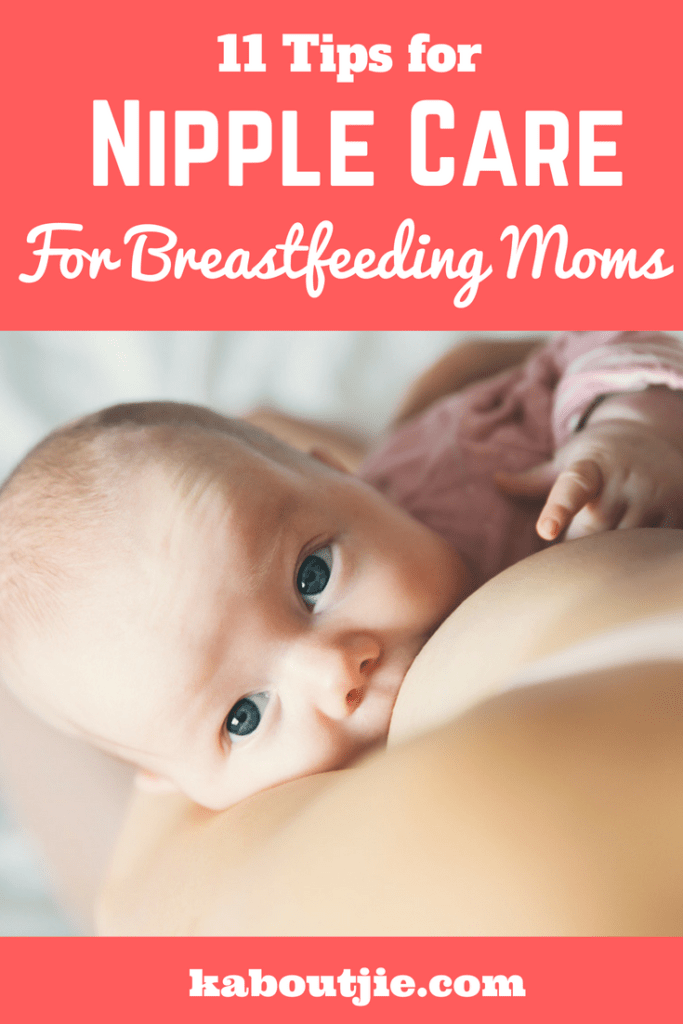When it comes to nipple care for breastfeeding moms, there are a few tips and tricks that you can apply to avoid experiencing broken and bleeding nipples when breastfeeding your baby.
Nursing shouldn’t be painful and having broken and bleeding nipples are not a normal side effect of breastfeeding.
The main reason for experiencing this, is when a baby is not latching properly which can be very painful.
Sometimes just the slightest change in your nursing technique or positioning can make a big difference.
***Disclosure -The links in this post may contain affiliate links and I may receive a small commission if you make a purchase after clicking on a link.***

Tips for nipple care for breastfeeding Moms:
-
Check baby’s latch
The best position to latch is off-centre with more of bottom part of the areola in your baby’s mouth.
The best way to get baby to latch on correctly is to line up her nose to the same height as your nipple so that the bottom gum is far away from the base of your nipple when she opens her mouth. Once the mouth is open, put her mouth on q. The nipple should be far back in your baby’s mouth.
It is very important to make sure that your baby is latching correctly, as she might not be getting enough milk.
Avoid pulling baby off a breast while he or she is nursing. Use your finger to break the suction in the corner of the mouth to stop the breastfeeding.
-
Try different nursing positions
Certain positions make correct latching easier and are more comfortable than others.
-
Clean your nipples gently & use antibacterial ointment
- If you have a bleeding or cracked nipple, rinse the breast after nursing with water to reduce infection.
- Don’t use alcohol, lotions, powders or perfumes on the nipples.
- Once a day, use an antibacterial, non-perfumed soap to gently clean the wound and rinse well with water.
- Using soap on the nipple area is not recommended unless the skin is injured or broken.
- Purified, medical-grade modified lanolin ointment can be used by rubbing a small amount of this ointment on your nipples after every feed.
- This treatment will allow wounds to heal faster without forming a scab and helps for pain relief. You don’t have to wash it off before feedings.
- When the cause for cracked nipples are due to thrush, treatment is begun with nystatin and if the mother is symptomatic, then the mother and baby can be treated.
- Continuing to breastfeed helps the nipple to heal. You can also apply expressed breast milk to your nipples to promote the healing process. This can be done in addition to other treatments.
-
Nurse on the less “injured” side first
Babies tend to nurse more gently on the second side because they are less hungry. Make sure you nurse with this side first when breast feeding the next time.
-
Apply a cold pack before nursing
Apply a cold pack or ice to numb the sore area before nursing as cold can help dull the pain during the initial latch which usually hurts the most.
-
Use hydrogel dressings for nipple healing
These pads are designed for nipple healing. They are soothing and speed up the healing process. Avoid touching your nipple or areola before applying the hydrogel dressing pad to avoid bacteria from your fingers getting trapped underneath. Frequent changing of breast pads is advised.
-
Make use of nipple shields
Making use of nipple shields is ideal for Moms that experience latching problems or that have flat or inverted nipples. The nipple shield is designed to look like and extended nipple and gives the baby a larger area to latch onto.
They are easy to use and must be sterilized after every use.

-
Take a break from breast feeding
If nursing becomes to painful to bear, you need to stop nursing for a day to allow your nipples to heal. You can use a breast pump to express milk from the injured side in to maintain milk supply and reduce the risk of mastitis. If the pump is too painful, you can try hand expression.
If a cracked nipple is still painful and bleeding after 24 hours or if you notice any signs of inflammation, oozing, infection or experience fever symptoms, check with your healthcare practitioner. Bacteria can get in through the open wound and lead to breast infections such as mastitis.
-
Take painkillers
About 30 minutes before your next feed you can take ibuprofen or acetaminophen to help lessen the pain and swelling.
-
After nursing – saline solution soak
Mix ½ teaspoon of salt in a cup of warm water to make your own saline solution. After nursing, soak nipples in a small bowl of warm saline solution for a minute or two or at least long enough for the saline to get onto all areas of the nipple.
Alternatively, put the saline solution in a squeeze bottle and squirt it on gently.
Pat dry gently with a paper towel.
Your baby might not enjoy the taste of residual salt on your nipples. Rinse your nipples in a bowl of plain water before your next feed and pat dry gently.
-
Expose nipples to air
Keep exposing your nipples to air whenever possible. When you are wearing a bra, use disposable breast pads and change them when damp.
Some mothers make use of breast shells to protect nipples from dampness and friction of the bra.
- Wear loose fitted bras with no under wiring, as they can cause blocked ducts and mastitis.
- Avoid tight fitting clothes that restricts your nipples from airing.
Conclusion
Being able to breastfeed your baby is a wonderful experience that you can share with your little one, and your breast milk contains powerful antibodies that will help your baby to fight off bacteria and viruses. It lowers your baby’s risk of having asthma or allergies and has an array of other benefits.
By following these simple tips when it comes to nipple care for breastfeeding moms, you can avoid having painful broken and bleeding nipples and at the same time make your breast feeding journey a memorable and bonding experience.
 Kaboutjie SA Mommy Blogs by Lynne Huysamen
Kaboutjie SA Mommy Blogs by Lynne Huysamen





Oh yes please! I suffered so much with nipple pain when breastfeeding in the past. It nearly put me right off breastfeeding. Now that I’m preparing for the arrival of #3 this will come in handy.
This information was very helpful thank you so much I will definitely use some of those points made
Thank you so much, this is sooo helpful. One of my nipples is painful feels like its falling off my breast.